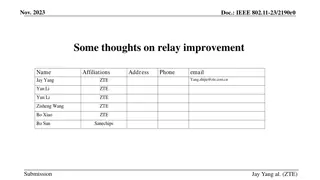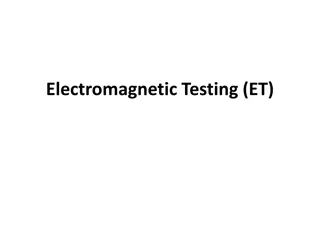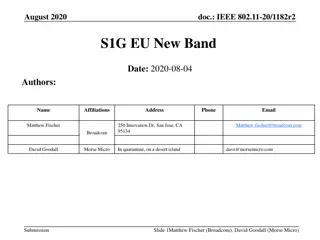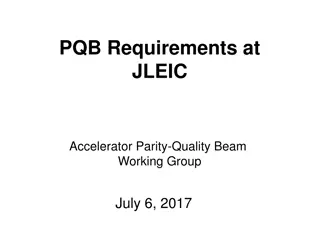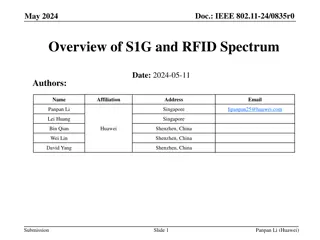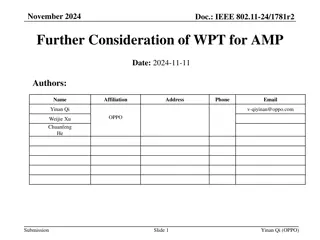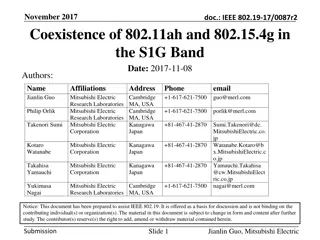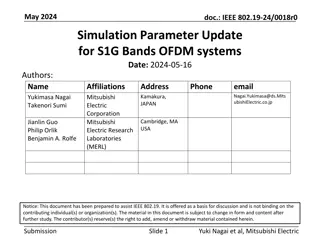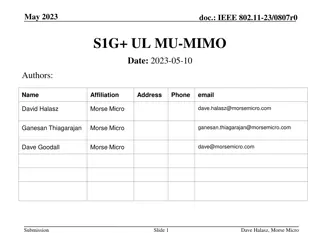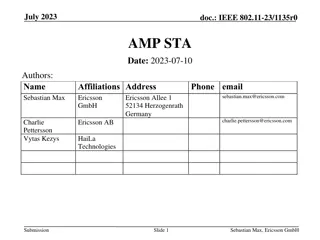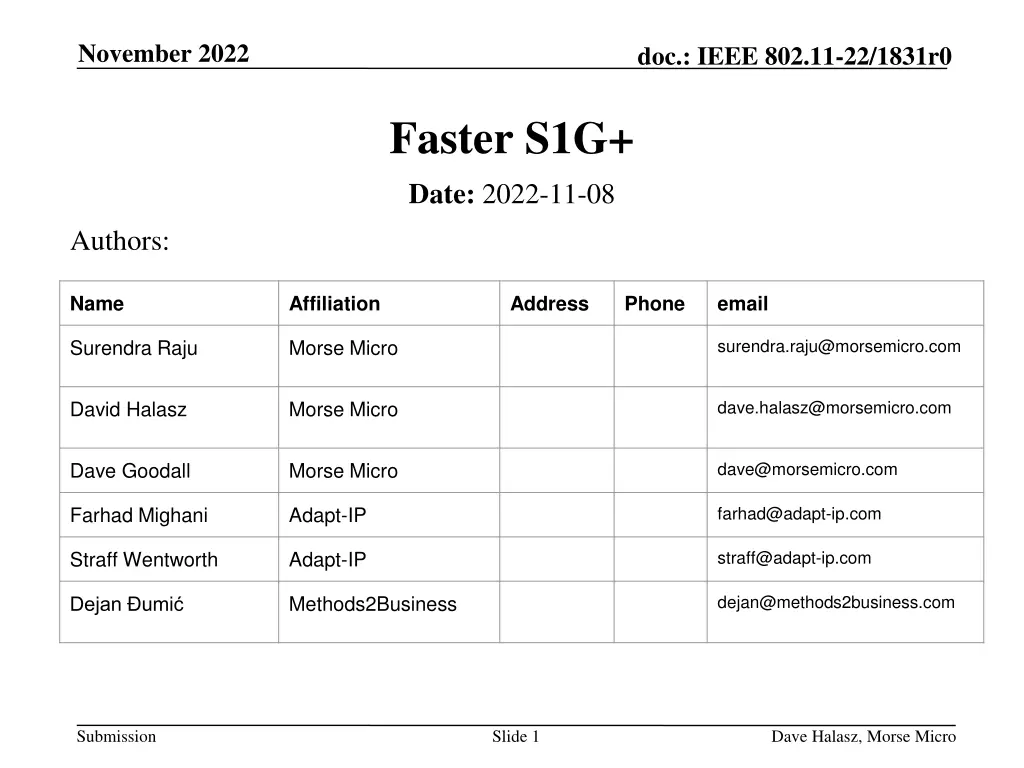
Enhancing Sub 1GHz Wireless Communication with IEEE 802.11-22/1831r0
Explore the advancements in Sub 1GHz wireless communication through IEEE 802.11-22/1831r0, focusing on increased throughput, usage of 1024 QAM, and theoretical rates achieved. Learn about the benefits for low-power cameras and video applications, as well as how newer PHYs improve functionality for Sub 1GHz operations.
Download Presentation

Please find below an Image/Link to download the presentation.
The content on the website is provided AS IS for your information and personal use only. It may not be sold, licensed, or shared on other websites without obtaining consent from the author. If you encounter any issues during the download, it is possible that the publisher has removed the file from their server.
You are allowed to download the files provided on this website for personal or commercial use, subject to the condition that they are used lawfully. All files are the property of their respective owners.
The content on the website is provided AS IS for your information and personal use only. It may not be sold, licensed, or shared on other websites without obtaining consent from the author.
E N D
Presentation Transcript
November 2022 doc.: IEEE 802.11-22/1831r0 Faster S1G+ Date: 2022-11-08 Authors: Name Affiliation Address Phone email Surendra Raju Morse Micro surendra.raju@morsemicro.com David Halasz Morse Micro dave.halasz@morsemicro.com Dave Goodall Morse Micro dave@morsemicro.com Farhad Mighani Adapt-IP farhad@adapt-ip.com Straff Wentworth Adapt-IP straff@adapt-ip.com Methods2Business dejan@methods2business.com Dejan umi Submission Slide 1 Dave Halasz, Morse Micro
November 2022 doc.: IEEE 802.11-22/1831r0 Abstract The Sub 1 GHz PHY was based on IEEE 802.11ac. Newer PHYs have introduced functionality which would be beneficial to Sub 1 GHz operation. Submission Slide 2 Dave Halasz, Morse Micro
November 2022 doc.: IEEE 802.11-22/1831r0 Faster Use Case Camera & Video Use Case IEEE 802.11ah useful for low power cameras and video. Higher rates will enable higher resolution and more streams Submission Slide 3
November 2022 doc.: IEEE 802.11-22/1831r0 Increased throughput for 802.11ah IEEE 802.11ah based on IEEE 802.11ac Use features brought in post IEEE 802.11ac to improve throughput 1024 QAM was added in IEEE 802.11ax Submission Slide 4 Dave Halasz, Morse Micro
November 2022 doc.: IEEE 802.11-22/1831r0 Increased throughput for 802.11ah Usage of 1024 QAM - rate - rate - same puncturing patterns as for other rates - Interleaver parameters aligned for 1024 QAM Parameter 1MHz 2MHz 4MHz 8MHz 8 13 18 26 Ncol 3*10 4*10 6*10 9*10 Nrow 2 11 29 58 Nrot MCS mapping - Constellation mapping borrowed from 802.11ax (section 26.3.11.8) - SIG field has 4 bit MCS - MCS11 rate 1024-QAM - MCS12 rate 1024-QAM Submission Slide 5 Dave Halasz, Morse Micro
November 2022 doc.: IEEE 802.11-22/1831r0 Increased throughput for 802.11ah Theoretical rates achieved Data Rate (Mbps) 1 MHz Bandwidth 2MHz Bandwidth 4MHz Bandwidth 8Mhz Bandwidth Spatial Streams Modulation Type MCS Coding rate 8 ? ?sec GI 4 ? ?sec GI 8 ? ?sec GI 4 ? ?sec GI 8 ? ?sec GI 4 ? ?sec GI 8 ? ?sec GI 4 ? ?sec GI MCS11 1 1024-QAM 3/4 4.5 Mbps 5.0Mbps 9.75 Mbps 10.833Mbps 20.25 22.5 43.875 48.75 MCS12 1 1024-QAM 5/6 5 Mbps 5.55Mbps 10.833 Mbps 12.03 Mbps 22.5 25 48.75 54.1667 TX EVM requirement < -35 dB Submission Slide 6 Dave Halasz, Morse Micro
November 2022 doc.: IEEE 802.11-22/1831r0 1024 QAM and rates (shown as MCS11 & MCS12) LGI, SGI, Travelling, Fixed pilot modes Submission Slide 7 Dave Halasz, Morse Micro
November 2022 doc.: IEEE 802.11-22/1831r0 Traffic typically in the uplink direction Uplink Multi User MIMO was added in IEEE 802.11ax Cameras, sensors using UL MU-MIMO will increase system level performance Submission Slide 8
November 2022 doc.: IEEE 802.11-22/1831r0 Sub 1 GHz typically operating in areas with other systems Preamble puncturing was added in IEEE 802.11ax and then extended in IEEE 802.11be. Preamble puncturing allows some bandwidth to be skipped Interference or adjacent cell Punctured Bandwidth Channel Bandwidth Submission Slide 9
November 2022 doc.: IEEE 802.11-22/1831r0 Straw poll Do you agree to the formation of a Study Group to develop a PAR and CSD for addition of functionality from existing PHYs, such as 1024-QAM, Uplink MU- MIMO and puncturing to Sub 1 GHz operation, to enable increased throughput operation? Submission Slide 10 Dave Halasz, Morse Micro
November 2022 doc.: IEEE 802.11-22/1831r0 References Submission Slide 11 Dave Halasz, Morse Micro

